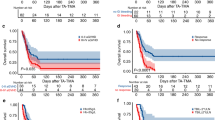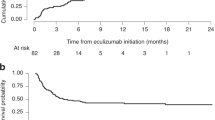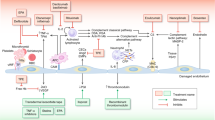Abstract
Thrombotic microangiopathy (TMA) is an infrequent but serious complication of allogeneic transplantation. The success rate of plasma exchange (PE) reported in the treatment of this entity is a controversial subject. We report the outcome of 10 patients with TMA post-allogeneic transplantation after treatment with PE. Two out of the 10 patients have not responded, five had a partial response, but died of acute GVHD or interstitial pneumonitis, and three have responded and recovered. Our study suggests that there are different degrees of TMA severity. Only mild multifactorial cases with no severe hemolysis (LDH activity <1000 u/l) may be fully resolved with pe.
This is a preview of subscription content, access via your institution
Access options
Subscribe to this journal
Receive 12 print issues and online access
$259.00 per year
only $21.58 per issue
Buy this article
- Purchase on Springer Link
- Instant access to full article PDF
Prices may be subject to local taxes which are calculated during checkout
Similar content being viewed by others
Author information
Authors and Affiliations
Rights and permissions
About this article
Cite this article
Llamas, P., Romero, R., Cabrera, R. et al. Management of thrombotic microangiopathy following allogeneic transplantation: what is the role of plasma exchange?. Bone Marrow Transplant 20, 305–306 (1997). https://doi.org/10.1038/sj.bmt.1700889
Received:
Accepted:
Issue Date:
DOI: https://doi.org/10.1038/sj.bmt.1700889
Keywords
This article is cited by
-
Early clinical indicators of transplant-associated thrombotic microangiopathy in pediatric neuroblastoma patients undergoing auto-SCT
Bone Marrow Transplantation (2011)
-
Transplantation-associated thrombotic microangiopathy: effect of concomitant GVHD on efficacy of therapeutic plasma exchange
Bone Marrow Transplantation (2010)
-
Vincristine is an effective therapeutic approach for transplantation-associated thrombotic microangiopathy
Bone Marrow Transplantation (2006)
-
Transplant-associated microangiopathy (TAM) in recipients of allogeneic hematopoietic stem cell transplants
Bone Marrow Transplantation (2005)
-
Transplantation-associated thrombotic microangiopathy: twenty-two years later
Bone Marrow Transplantation (2002)



